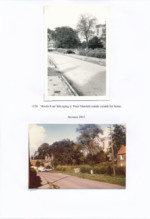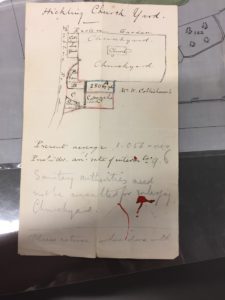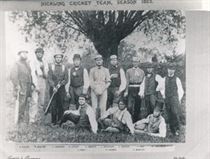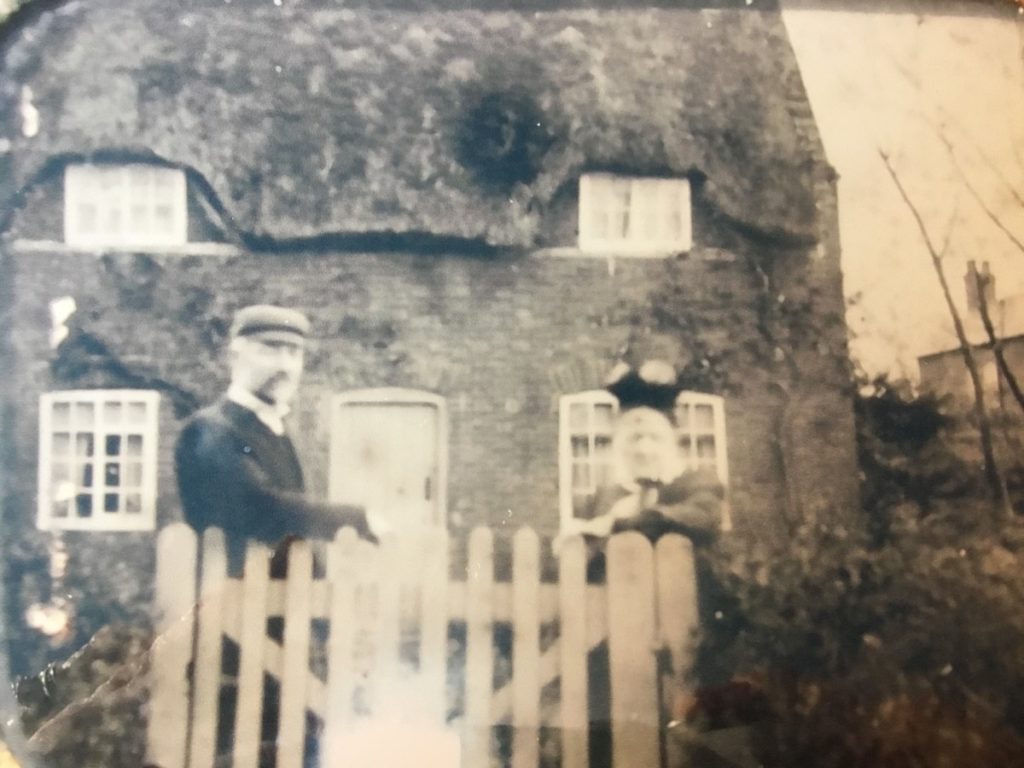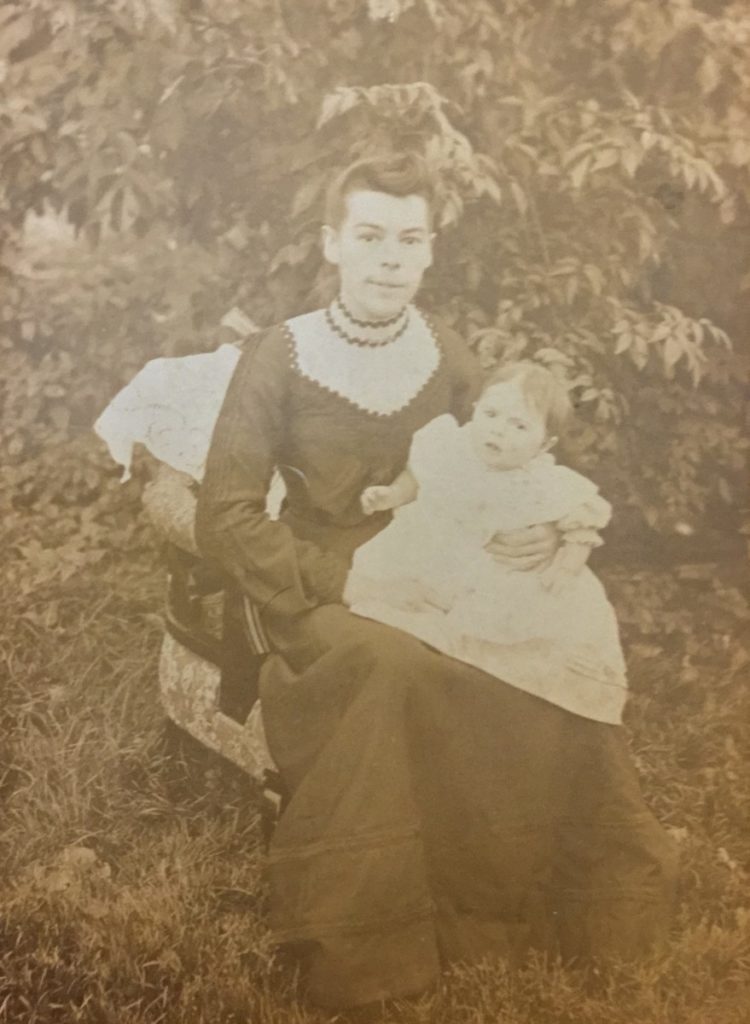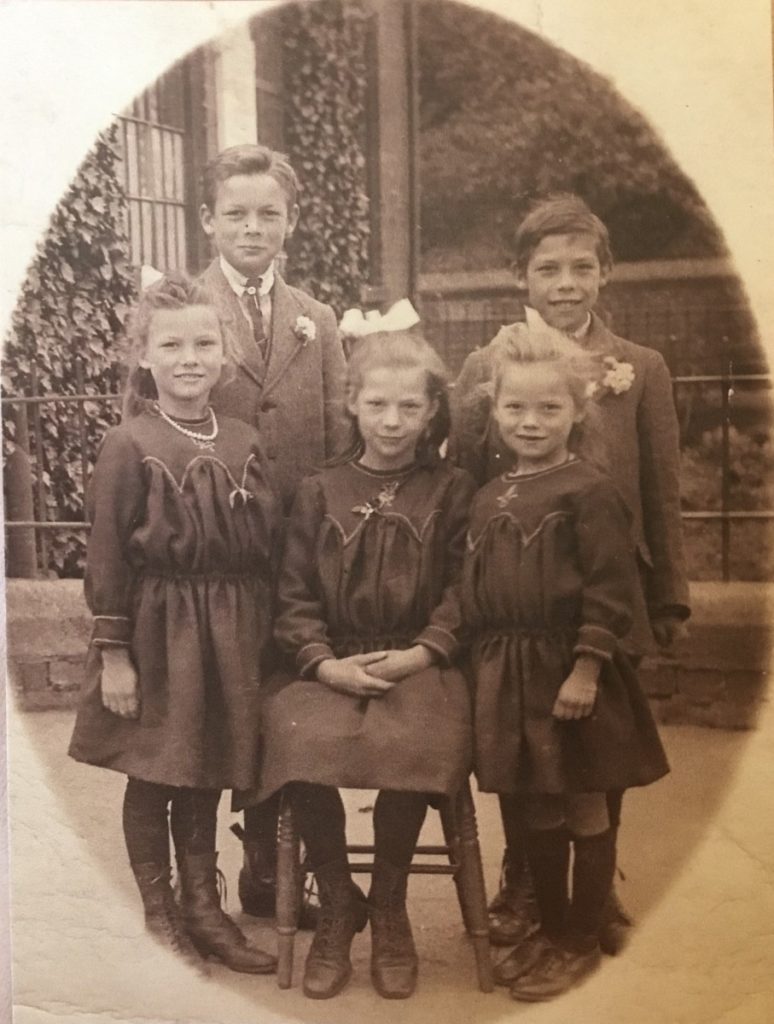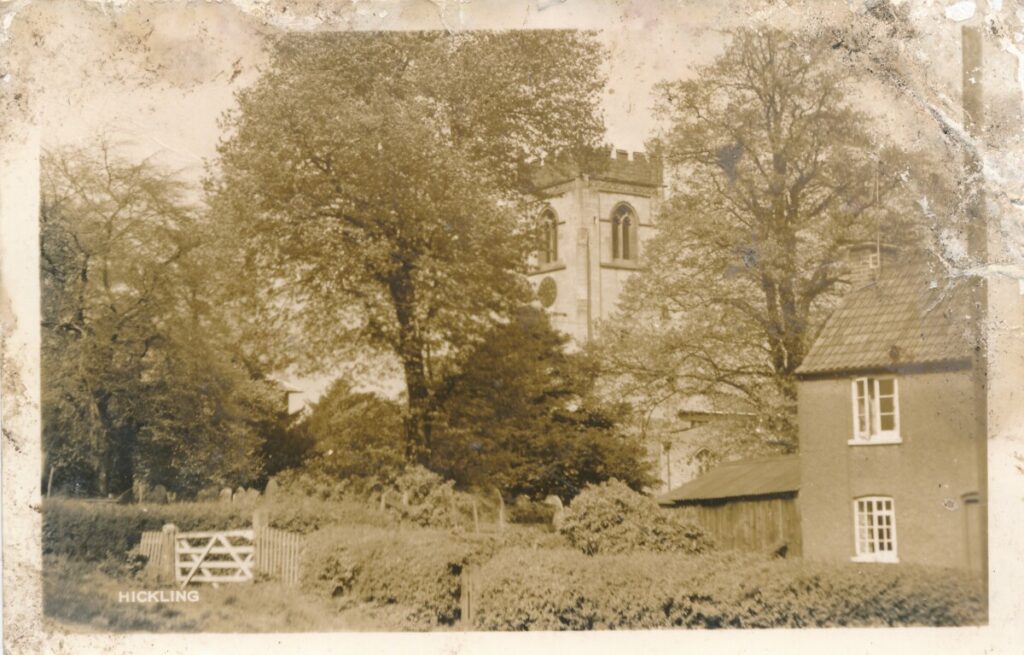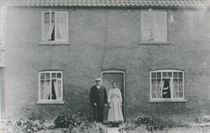
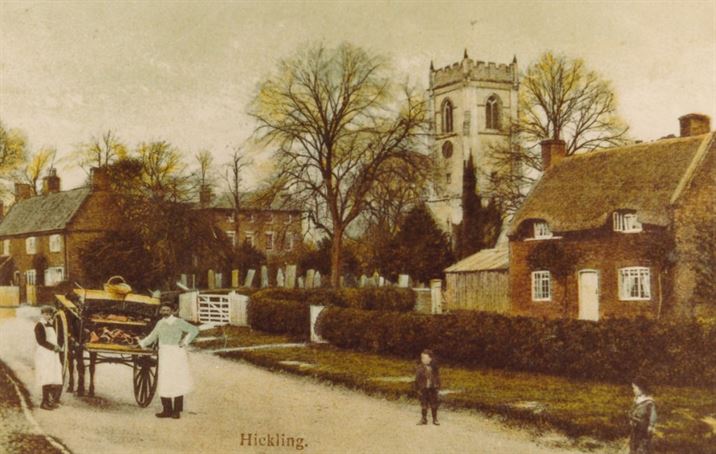
Property Name:
The cottage is most commonly referred to as Glebe Cottage but it is also referred to as Parson’s Cottage, the Church Cottage (and several variants) and Flood Cottage. ‘Glebe’ refers to land and property which is in the ownership of the Church and which generates income for the incumbent of the Parish.
Unfortunately, there are no clear references to the property by name until it is referred to in the Wadkin archives (written in the 1980s and 1990s and recording events and families from the 1880s onwards):
- Church correspondence in the late 1800s simply refers to ‘the cottage’.
- Ownership and tenancy is unclear through the 1800s; but it appears that the cottage and land was owned by Queens’ College Cambridge as patrons holding the property for the benefit of the incumbent. Occupiers are likely to have been tenants.
- There is no recorded use of the name Glebe Cottage until much later and in the census of 1911 it is referred to as Flood Cottage. Reference to it as simply the Cottage, the Church Cottage, Church View Cottage, Parson’s Cottage seem vague and generic in nature but were probably sufficient at a time when homes often weren’t individually named but referred to by the person who lived in them or by distinctive features nearby.
- Church correspondence records that the Magson family ‘owned’ a piece of land on the Glebe Cottage site in the late 1800s and that Emma Magson gifted it (back?) to Queens’ College in September 1896; none of the correspondence (1885-1917) refers to the property by name.
Ownership/tenancy of Glebe Cottage:
It is unclear when the cottage was built but it may be identifiable on the 1774 Enclosure Map and it would appear to have been tenanted in the 1830s (and possibly as far back as 1814) – see timeline, below.
The land and cottage directly bordering the graveyard seem to have been in the ownership of Queens’ College Cambridge – as patrons of the Church in Hickling, they had held and managed property for the benefit of the incumbent since the mid-1600s.
We are told in Church correspondence in April 1885 that land that had belonged to a ‘man named Magson’ was now in the hands of T Magson who was willing to sell the 280 square yards wanted by the church for an extension of the graveyard for £15. This presumably never happened because in September 1896 Emma Magson gifted the 280 square yards to Queens’ College.
- In further correspondence ‘the man named Magson’ is identified as the father of T Magson; this was John Magson (senior).
- John Magson (senior), died in January 1870; he had been a labourer all his life which makes it unlikely that he owned a property like Glebe Cottage.
- The Church correspondence is very unclear and questions are raised on a number of occasions trying to clarify issues of ownership and tenancy of both the land and the property; unfortunately, the correspondence is not complete enough to work out what was happening with any certainty (enquiries are ongoing).
Lawsuit: Anderson/Magson
With the information currently available it would seem that as a result of a lawsuit between John Magson (senior) and the Rev’d Edward Anderson (incumbent 1820-1843), John Magson acquired ownership of a piece of land alongside the graveyard.:
- Edward Anderson was incumbent between 1820 until his death in 1843; the lawsuit must have taken place during this period.
- It seems from the later correspondence that at some time in the 1820s or 1830s, the Rector (Edward Anderson) was attempting to purchase the property and land currently known as Glebe Cottage; it isn’t clear who he was buying from but in the course of the transaction he appears to have lost a lawsuit which resulted in a section of the land neighbouring the churchyard (280sq yds) moving into the ownership of John Magson (senior); he was likely to have been the tenant of the property at the time.
- This seems to indicate that the Magson family were tenants of the glebe property but acquired ownership of a small part of it. Some time after John Magson (senior) died in 1870 his son, Thomas, offered to sell this piece back to the Church/Queens’ College for £15 (correspondence in 1885). This failed to go through and in 1896, Emma Magson gifted it. Perhaps John (senior’s) descendants felt uncomfortable about the way the piece of land had been acquired?
- No trace has been found of the details of this lawsuit; enquiries are ongoing with Queens’ College, Cambridge whose archives are most likely to contain information on this.
- (see also Glebe Cottage families, below)
If John Magson was a tenant of Glebe Cottage and then managed to acquire ownership of part of the plot, it might explain why someone of relatively lowly means remained at the same property for such an extended time.
- In correspondence in 1885, Thomas Magson (son of John Magson) is offering to sell the plot of land for £15 and in 1896 Emma Magson gifts this piece of land to Queens’ College.
- Probate records in the 1890s for John (son) and Emma Magson don’t include valuations large enough to suggest the family owned the entire plot (property and land).
Timeline and Notes:
It is unclear when the cottage was built but it would appear to have been tenanted in the 1830s (and possibly as far back as 1814) and it may be indicated on the 1774 Enclosure map.
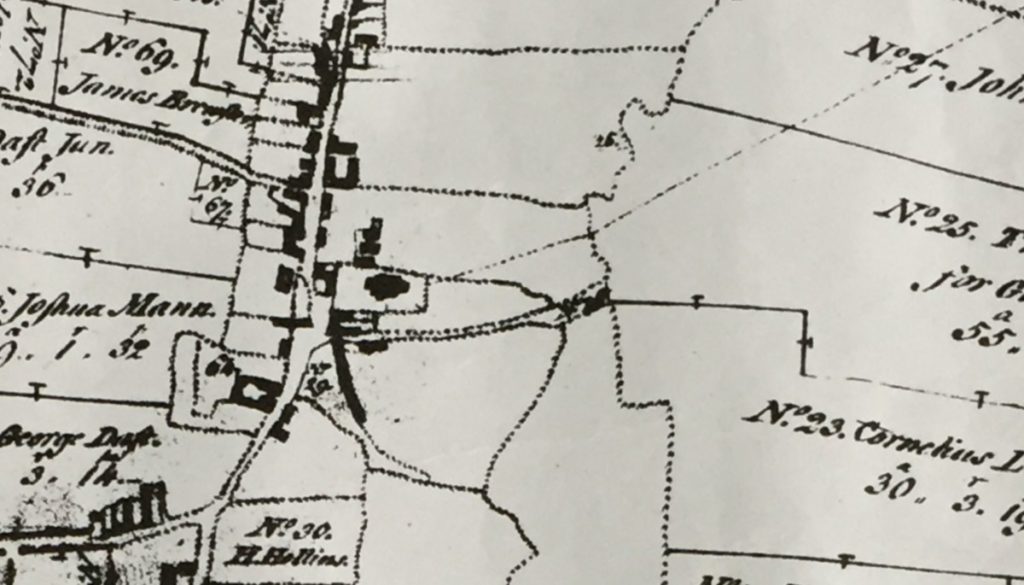
- The cottage was originally thatched which implies that it is older than (and of a different design to) the several farm cottages through the village which share a distinctive style and were largely built in the mid-1800s (flemish brick work and lower roof pitch, for example).
- The Enclosure Map of Hickling from the 1770s is unclear; however, there does seem to be a property shown on the Glebe Cottage site and it seems to match the lines found on the later 1884 OS map (more research needed).
- The property is marked (but not named) on OS maps from 1884 onwards.
- 1800s: There are a number of records in Hickling (Parish & Census) for the Magson family; these all relate to the family of John and Elizabeth Magson; two of their sons remained in Hickling through most of the 1800s. Families often moved around their home villages living in different properties over time but it is possible that John and Elizabeth, with their son Thomas, lived in the cottage over a series of decades. Incomplete church correspondence indicates that the Magson family may have been tenants of the cottage and owners of some of the land since the 1830s (and possibly as early as 1814 when they married in Hickling).
- September 1896: Emma Magson inherits the Estate of her father, John Magson. She immediately makes a gift of land to Queens’ College, Cambridge who hold it for the benefit of the Rector (the Church in Hickling was under the patronage of Queens’ College).
- The Wadkin archives refer to Mr George and Mrs Martha Wiles on Chapel Lane but also at Church Cottage before their son, Thomas took up residence there (little confirmed detail); it is likely that the Wiles family followed the Magson family as tenants but it is unclear at what date.
- 1904: An original postcard labelled 1904 shows the cottage thatched and with exposed brickwork; there is also a large wooden farm building extending at right angles to the cottage at the front of the plot.
- On a wax paper drawing of the churchyard and Glebe Cottage (after 1905 and probably from c.1916); the cottage and land to the roadside of the churchyard are shown in the occupation of Thomas Wiles. Mr TW Collishaw is owner of the land neighbouring the churchyard and east of Glebe Cottage. (Thomas Wiles was also involved in the new cemetery arrangements in the 1950s).
- 1911 Census: the property is listed as Flood Cottage (which links with the naming of Waterlane Farm – both properties bear the brunt of flooding in this part of the village). It is occupied by Thomas (grazier) and Katherine Wiles.
- 1916: Church correspondence, “The cottage is in such a dilapidated state that it requires a new roof at a cost of £95 to £100 I am prepared to carry this out by a loan if the college will sanction it. This property has never been assessed for dilapidations but it has been a source of constant expense.”
- Wadkin Archives record the cottage as still being thatched in 1923/4.
- (Hickling Draft Neighbourhood Plan 2020): This 2020 document explains that it was likely that the cottage was occupied by employees at The Rectory but this doesn’t seem to have been a formal arrangement and there are only occasional records of such links (for example, George and Martha Wiles). The Magson family appear to have been tenants for much of the 1800s; John Magson (senior) was an agricultural labourer and Thomas Magson was a journeyman tailor. Similarly, Thomas Wiles (occupant for a number of years from c.1904) is listed in census records as a grazier in his own right (although possibly grazing glebe land?). It is more likely that it was rented and tenants paid a rent to the Rector/Queens’ College.
- C.1930: A photograph of Mr & Mrs John Mann in front of the cottage after the thatch has been replaced with tiles and the brickwork covered with rendering. There is a possible census record for John Mann in Hickling in 1911; if this is the same individual he was listed as a grazier.
- Subsequent tenants include (with very approximate dates); The Mann family (c.1930s), Slater Shelton (1930s), The Sponge family (1939 Register) and the Harrisons in the 1950s.
- 1939 Register: the first official reference to the property as Glebe Cottage (occupied by the Sponge family)
- (Hickling Draft Neighbourhood Plan 2020): “… between 1951 and 1976, the incumbent Rector resided part of the time at Glebe Cottage and moved there permanently prior to The Rectory being sold in 1979. The extension to the rear was added in the late 1970s.” (see families, below).
- The Rev’d Leslie Harwood came to an arrangement whereby, after his death, his son could continue to live in the property for his lifetime or until he chose to move away. This arrangement came to an end in mid-2020.
- In late 2020 the Church/Southwell Diocese sold the property and it is lovely to see the cottage undergoing sensitive renovation and coming back to life as a family home.
Glebe Cottage families:
There are no confirmed records of either ownership or tenancy before a reference in correspondence in 1885 to a lawsuit sometime between 1820 and 1843 and then a mention of T Magson as owner/occupier also in 1885.
(enquiries are ongoing with Queens’ College, Cambridge)
Magson family (pre-1881 to c.1896):
Through the 1800s there is only one Magson family in census records (John and Elizabeth Magson and their children); the brothers John (b.1820) and Thomas (b.1826) and John’s daughter, Emma (b.1852) are linked to Glebe Cottage. John and Thomas are both tailors throughout their working lives and their father was an agricultural labourer.
The earliest reference to the Magson family and Glebe Cottage is in correspondence in 1885 in relation to enlarging the neighbouring graveyard and it is the unmarried Thomas who is named. It is unclear when the family came to Glebe Cottage but the correspondence surrounding a lawsuit in the 1820s/1830s potentially places him and his parents as tenants of the Glebe Cottage property (possibly as early as 1814).
John Magson (baptised 1819) and Thomas Magson (baptised 1826) were the sons of John (born Little Dalby) and Elizabeth (nee Worthington, born Cropwell Bishop) Magson (see Magson family page for further details, including census information).
- John Magson (of Little Dalby) married Elizabeth Worthington (of Cropwell Bishop) in Hickling on 6th June 1814. Marriage records state they were both resident in Headon-cum-Upton near Retford in North Notts at the time of their Banns being read; witnesses at the wedding were Samuel Pitts and Sarah Grice. Although neither were resident in or native to Hickling they married here and settled until their deaths in 1870 and 1872 respectively.
- It is possible that they took up residence at Glebe Cottage at the time of their marriage in 1814 (unconfirmed). They appear to have been there at some point between 1820 and 1841 because of the lawsuit – details to be confirmed.
- John Magson (senior) was buried in Hickling on 31st January 1870 age 81yrs and his wife, Elizabeth (nee Worthington) Magson was buried in Hickling on 13th June 1872 aged 81yrs.
It is likely that the Magson family occupied Glebe Cottage continuously; possibly from the time of John & Elizabeth’s marriage in 1814 until John’s death in 1870; their tenancy is less clear after this. Whilst it is likely to be John, Elizabeth and their son, Thomas, in residence for most of this period, there is too little specific detail in public records to explain which part of the family was resident at which time.
Thomas Magson:
- Census records indicate that Thomas never married.
- Apart from the census of 1841 (when there is no listing for Thomas in Hickling), Thomas is listed in the parental household each decade until 1871. In 1881 he is listed living alone (in what seems likely to be Glebe Cottage) but in 1891 he is listed as a lodger in the Brewin household. He is consistently referred to as a tailor or a journeyman tailor.
- Thomas Magson appears in a photograph of the Hickling cricket team in 1863.
- In the census of 1871 Thomas is living with his widowed mother who is head of household at ‘Brewhouse Yard’; this is listed between Burnetts and Long Lane which probably places them at the south end of the village and not at Glebe Cottage.
- In the census of 1881 Thomas Magson is listed (still as a journeyman tailor) as sole occupant in a house between the Rector and farmer Collishaw (Waterlane Farm) – one unoccupied house is listed between them, too. This is a probable reference to him at Glebe Cottage.
- In 1885 correspondence between Canon Skelton (Rector) and Queens’ College includes a plan of the land owned by the College and the land owned by the Magson family; Thomas Magson has offered to sell his portion of the plot (280sq yds) to the Church for £15.
- However, in the census of 1891, Thomas is recorded as a lodger in the Brewin household (in other words, he is unlikely to be at Glebe Cottage). The Wadkin Archives refer to the Brewin household on Chapel Lane (now Bridegate Lane).
Thomas Magson died at the age of 67 and was buried in Hickling on 2nd December 1893; no Will or probate records have been found for him.
John Magson (son):
At some point land ownership (plus occupancy and/or tenancy?) passed to Thomas’s brother, John; in 1895 the parcel of land was described as belonging to him. John Magson was buried in Hickling on 14th July 1896; there are two probate records. He leaves his effects to his daughter Emma and after her death to his grandson (& Emma’s nephew) George Wright:
- Probate Nottingham 23rd April to Emma Magson spinster effects £90. Further grant November 1897.
- Magson John of Hickling Nottinghamshire tailor and draper died 11th July 1896 Administration (with Will) (Limited) Nottingham 10th November to George Wright ironworker Effects £90. Former grant April 1897.
Emma Magson:
In September 1896 (two months after her father’s death) Emma Magson is reported to have gifted the Glebe Cottage land and property to Queens’ College, Cambridge to be held for the benefit of the incumbent Rector. It isn’t entirely clear that the gift is reflected in changes to the value of John Magson’s Estate as it transfers from him to Emma and then Emma to George Wright; unless the drop from £90 to £45 includes the c.£15 gift of the land?
Emma did not marry. After her father died she gives all the appearance of being dependant on her relatives. She went to live with an aunt in Bingham but then, aged 45, came back to Hickling in April 1897 and stayed with various people in Hickling over the next few days. She stayed for a few days with an Elizabeth Price, widow, then left to visit relations, saying she would be back in a few days. Price had apparently taken Emma in because Emma had tried several other places and no one would take her in (although these accounts are slightly contradictory). She is reported to have met Alwyn Frank Shelton, blacksmith, in the morning that she left and told him she was going for a train. George Faulks, grazier, found her body in Clawson Lane the following morning, she had drunk carbolic acid (newspaper report transcription can be found on the Magson family page).
Emma Magson was buried in Hickling churchyard on 22nd April 1897; probate was issued on 22nd May 1897:
- Magson Emma of Hickling Nottinghamshire spinster died 20th April 1897 Administration (Limited) Nottingham 22nd May to George Wright ironworker Effects £45.19s.
Queries:
- There is some confusion over Thomas Magson’s residence in the census records around and following the death of his parents; it would be useful to confirm what happens in these years (see Wiles family, below).
- More research is needed into Emma’s gifting of the property to the Church in September 1896. She appears to have been homeless and without any means of supporting herself; sadly, she committed suicide just a few months after making the gift.
- Where was John (son) Magson’s family living in Hickling?
Thomas & Katherine Wiles (c.1904–1920s?):
The Wadkin archives refer to Mr George and Mrs Martha Wiles on Chapel Lane but also at Church Cottage before their son, Thomas took up residence there (little confirmed detail); it is likely that the Wiles family followed the Magson family as tenants but it is unclear at what date.
In an undated photograph of George and Martha Wiles in front of a thatched Glebe Cottage (left hand image, below), the couple seem to be much younger than when they were living at End Cottage (behind Jasmine/Jessamine Cottage). It seems that immediately following George Wiles’ time working on the railways in Syston they lived elsewhere in Hickling (perhaps Chapel Lane) but moved into Glebe Cottage in the late 1880s; moving again when their son, Thomas, and his new wife took up residence in 1904.
In the 1911 Census: house is named as Flood Cottage:
- Thomas George Wiles – head – married – age 34 – b.1877, Syston, Leics – Grazier
- There is a baptism record for Thomas George Wiles, Barrow-upon-Soar, 1876 (mother’s maiden name, Milward)
- Census records (below) show that his father was native to Hickling and Thomas grew up in Hickling. He died in 1963 (age 86) and his probate records show him at Home Farm, Hickling.
- Katherine Annie Wiles – wife – age 36 – b.1875, Hickling (married 1905)
- Katherine Annie Doubleday of Hickling.
- Thomas George William Wiles – son – age 3 – b.1908, Hickling
- Frederick Herbert Wiles – son – age 1 – b.1910, Hickling
- Dorothy Wiles – daughter – age 0 – b.1911, Hickling
- Sarah Ellen Caunt – servant – age 13 – b.1898, Hose – General Domestic
Thomas and Katherine Wiles married in 1904; Katherine is listed in Hickling in the 1901 census but Thomas appears to be working as a footman in Derbyshire (possibly linked to his mother’s birthplace); it is likely that they moved into the cottage at the time of their marriage.
- An undated wax paper sketch of the cottage and neighbouring churchyard (possibly from the 1920s) labels the cottage as occupied by Thomas Wiles.
- A photograph from the 1920s (date unconfirmed) is labelled as the home of Thomas Wiles and his family.
- The family is listed in Hickling (with an evacuee in the household) in the 1939 Register; the house isn’t named but the listing places it on Main Street between The Post Office and the School House. Thomas is listed as a dairy farmer; family records place them at Home Farm which is where Thomas is located in probate records in 1963.
- (see Wiles family page for further details and census information)
“George Wiles who was a drayman at The Rectory, his family lived in Chapel Close (village end of what is now Bridegate Lane). George married Martha Milward who was a cook at The Rectory and they lived in Church View Cottage. George was born in 1855 and died in 1930. Tom was born in 1876 at Syston”
“… I remember Mr Mann when he retired and lived with his family in the Parson’s Cottage next to the churchyard, this cottage was always in danger of being flooded when heavy rains occurred, and many times I can recall when furniture was taken upstairs. When I was at school the Wiles family lived there Tom, Fred, Dorothy and Madge and Addie and Eva born at their present house and the Parson’s Cottage then had a thatched roof.”
(Maggie’s Memories p.57 & image labelling)
The Norton Family have kindly provided detail of the Wiles family and their time at Glebe Cottage:
- A photograph (below) of George and Martha Wiles at the gate of the thatched cottage.
- “My great grandparents George and Martha Wiles both worked at the Rectory for Canon Skelton. Martha came with the Skeltons as a cook from Belper where her father John Millward was a nail maker. After their marriage, George went to work on the railway at Syston (photograph, below, George is the third in on the front row wearing the white shirt).”
- “During this time, Thomas was born then they moved back to the village when their second son was born. It is not known where they were living unless it was the church cottage as the pictures show.”
- George and Martha’s son Thomas and Katherine Doubleday were married in 1904 and lived there until approximately 1916; there is a photograph of Katherine Wiles holding her first born child, Kitty, who sadly died aged 4.
- “After losing Kitty, they went on to have 6 more children – the 5 shown in the picture below were all born at Glebe Cottage. They are, from left to right, Marjory, Thomas, Dorothy, Sarah (known as Addie) and Fred. The youngest Eva (my mother) was born at Home Farm in 1917.”
- There is a further earlier photograph of Dorothy and Marjory outside the Glebe Cottage.
- “When the family moved up to Home Farm, Thomas still continued to farm Glebe land. William Marriott (Bill) along with his wife and family lived in Glebe cottage during the 1940s and 50s whilst working for Thomas who was still farming the Glebe land. After the death of Thomas in January 1963, his son Fred took over the Glebe land until it passed on to Rev Harwood.”
- “But we do know that in latter years, they lived in the small cottage at the back of Jasmine Cottage as we have numerous pictures of them there.” Referenced as the End Cottage they lived in the half which bordered the churchyard (now Jasmine or Jessamine Cottage) – a picture of it during later renovations is shown, below.
- “In the latter days, George worked alongside his son on the (Home) farm. George died in 1930 and Martha in 1931.”










Mr and Mrs John Mann (c.1930s):
Mr and Mrs John Mann are pictured outside the cottage c.1930s; by this time the cottage has a tiled roof and the brickwork has been rendered.
“Carriers. I do not remember Mr J Mann when he was a carrier with horse and cart to Nottingham, but I remember Mr Mann when he retired and lived with his family in the Parson’s Cottage next to the churchyard, this cottage was always in danger of being flooded when heavy rains occurred, and many times I can recall when furniture was taken upstairs. When I was at school the Wiles family lived there Tom, Fred, Dorothy and Madge and Addie and Eva born at their present house and the Parson’s Cottage then had a thatched roof.”
“Mr Mann was carrier for a number of years. I remember Mr and Mrs Mann living in Church Cottage. Mr Mann suffered with arthritis very badly in his later years, his wife a spotlessly clean woman took in washing. They had Billy, lived in the north and received decoration in the 1914-18 War. Dick a tram driver in Nottingham until retiring to Kinoulton. Maggie, Minnie, May Mann married and lived away. Sarah a maid at the Rectory in Canon Ashmall’s time, never married, and Florence also a maid at the Rectory, she married and lived away. Mr mann’s sisters were Mrs Susannah Shelton. Mrs Robert Parkes I remember on several occasions the Mann family moving their furniture upstairs because of floods at Church Cottage. There are not any Manns left in the district. Were members of the Parish Church.”
(Maggies Memories pp.57&92)
The Wadkin Archives places Slater Shelton (blacksmith) and his wife Margaret at Glebe Cottage in the late 1930s. They are said to have moved to Elm House at the south end of the village in the early 1940s; however, the 1939 register shows the Sponge family in residence at Glebe Cottage.
Herbert, Elizabeth and Horace Sponge:
1939 Register (record labelled Glebe Cottage):
- Herbert Sponge b. 8th October 1860, retired blacksmith
- Elizabeth Sponge b. 21st December 1872, unpaid domestic duties
- Horace Sponge b. 19th July 1909 (son), dairy worker (heavy worker)
Marriott family (c.1950s):
The Coronation Parade in1953 includes photographs of June and Billy Marriott as children.
The Norton family record (see Wiles, above); “When the family moved up to Home Farm, Thomas still continued to farm Glebe land. William Marriott (Bill) along with his wife and family lived in Glebe cottage during the 1940s and 50s whilst working for Thomas who was still farming the Glebe land.”
The Wadkin Archive includes a photograph labelled ‘1956 Morris 8 car belonging to Peter Marriott stands outside his home’.
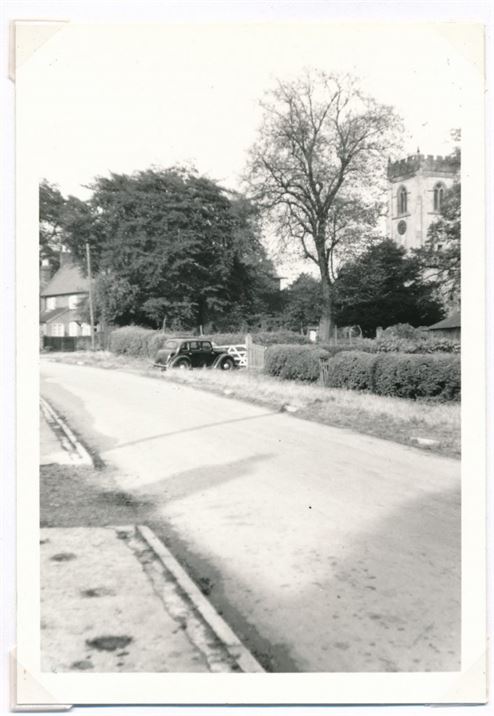
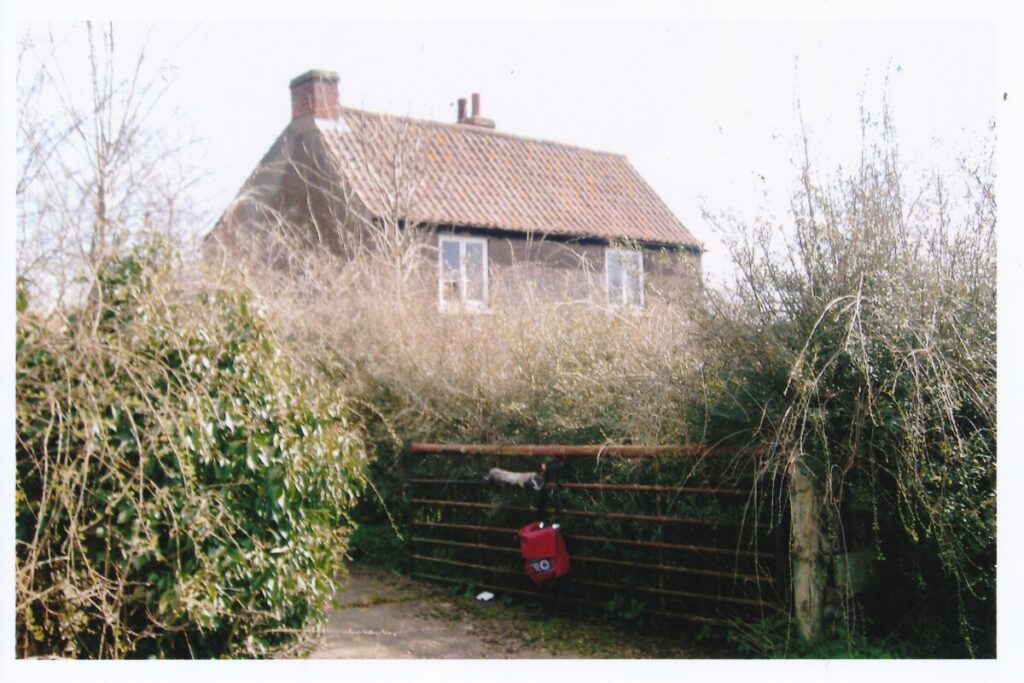
It seems that at some point in the 1950s the vicar, Rev’d Leslie Harwood, occasionally occupied Glebe Cottage; moving in permanently in 1979 when he retired and The Rectory was sold. An arrangement was made with the Diocese that following his death his son should be allowed to continue renting the property until his death or until he moved away permanently.
In late 2020, Mr Harwood’s son had moved away and the Church sold the property into private hands.
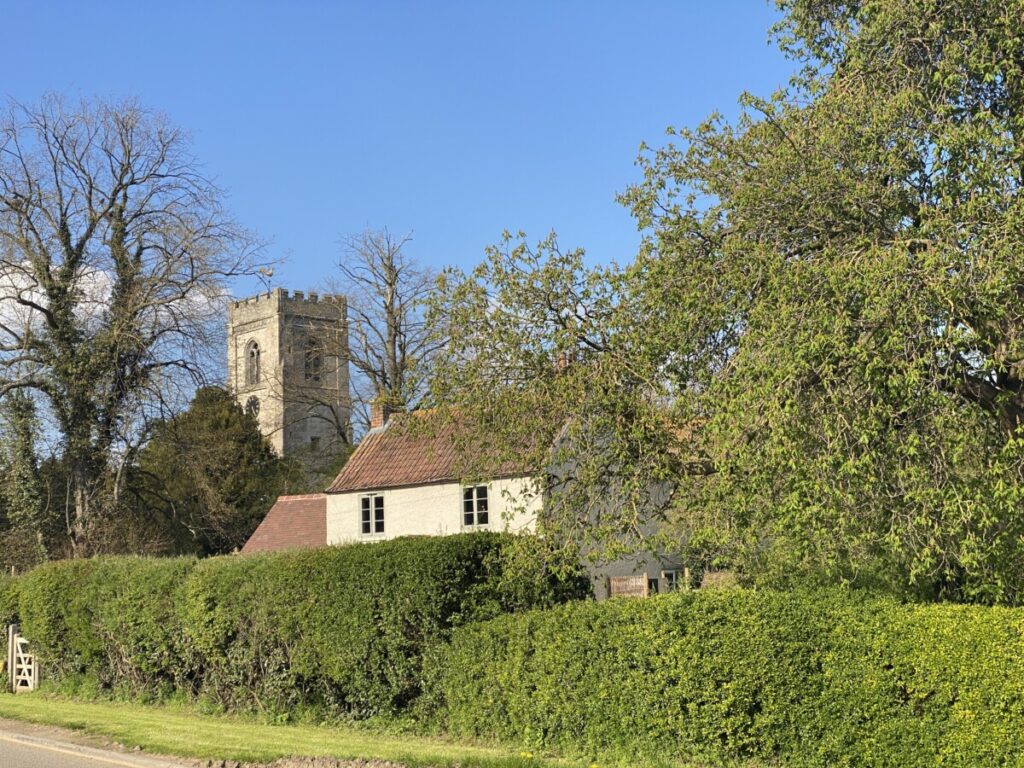
“Glebe Cottage is one of the oldest properties in the village, appearing on the 1884 map and is still owned by The Church of England. In postcard photos taken in 1904, the building is shown to have a brick facade with a thatch roof. Later photos from the late 1920s/1930s, show that tiles have replaced the thatch and rendering covering the brick. It is believed that the Cottage originally provided staff accommodation for those working at the Rectory, although between 1951 and 1976, the incumbent Rector resided part of the time at Glebe Cottage and moved there permanently prior to The Rectory being sold in 1979. The extension to the rear was added in the late 1970s. The descendants of the Rector are still tenants of the Cottage to date. The Cottage is registered on the Notts Historic Environment Record”
(Hickling Draft Neighbourhood Plan 2020)
This gallery is from the Wadkin Archives
